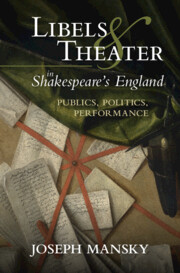68 results
11 - Staging Racial Passing
- from Part II - Black Optics
-
-
- Book:
- The Cambridge Companion to the Black Body in American Literature
- Published online:
- 09 May 2024
- Print publication:
- 16 May 2024, pp 159-175
-
- Chapter
- Export citation
Chapter 33 - Griselda Gambaro and Beyond: A “Dermography” of Contemporary Women’s Theater and Performance
- from Part III - Literary Names
-
-
- Book:
- A History of Argentine Literature
- Published online:
- 09 May 2024
- Print publication:
- 16 May 2024, pp 520-535
-
- Chapter
- Export citation
18 - Participatory Arts for Vulnerable Populations
- from Part V - Participatory and Community Arts
-
-
- Book:
- The Cambridge Handbook of Community Empowerment
- Published online:
- 18 April 2024
- Print publication:
- 25 April 2024, pp 457-479
-
- Chapter
- Export citation
6 - Loathsome Sympathy
-
-
- Book:
- Percy Shelley for Our Times
- Published online:
- 07 March 2024
- Print publication:
- 14 March 2024, pp 133-155
-
- Chapter
- Export citation
4 - How to Watch Jazz
- from Part I - Elements of Sound and Style
-
-
- Book:
- Jazz and American Culture
- Published online:
- 09 November 2023
- Print publication:
- 30 November 2023, pp 64-78
-
- Chapter
- Export citation

Libels and Theater in Shakespeare's England
- Publics, Politics, Performance
-
- Published online:
- 05 October 2023
- Print publication:
- 19 October 2023
Chapter 10 - Interlude
-
- Book:
- Staël, Romanticism and Revolution
- Published online:
- 03 August 2023
- Print publication:
- 17 August 2023, pp 100-108
-
- Chapter
- Export citation
Chapter 16 - Censorship
- from Part IV - Making the Modern Nation
-
-
- Book:
- The Nation in British Literature and Culture
- Published online:
- 20 July 2023
- Print publication:
- 10 August 2023, pp 276-291
-
- Chapter
- Export citation
19 - Post-World War II Theater and Media
- from Part II - Forms, Genre, and Media
-
-
- Book:
- The Cambridge History of American Modernism
- Published online:
- 13 July 2023
- Print publication:
- 20 July 2023, pp 334-348
-
- Chapter
- Export citation
Chapter 10 - ‘Translation Is Always Not Enough …’
- from Part III - ‘Translation at Large’: Dialogues on Ethics and Politics
-
-
- Book:
- Performance and Translation in a Global Age
- Published online:
- 10 August 2023
- Print publication:
- 29 June 2023, pp 229-243
-
- Chapter
- Export citation
2 - Klingemann and the Absurdity of Nothingness in The Nightwatches
-
- Book:
- A History of Nihilism in the Nineteenth Century
- Published online:
- 10 March 2023
- Print publication:
- 30 March 2023, pp 64-98
-
- Chapter
- Export citation
Chapter 5 - Money
- from Part II - Society
-
-
- Book:
- Chekhov in Context
- Published online:
- 16 February 2023
- Print publication:
- 23 February 2023, pp 42-48
-
- Chapter
- Export citation
Chapter 26 - Theatrical Traditions
- from Part IV - Literature
-
-
- Book:
- Chekhov in Context
- Published online:
- 16 February 2023
- Print publication:
- 23 February 2023, pp 198-204
-
- Chapter
- Export citation
Chapter 4 - Playing Culture
-
- Book:
- Rome and America
- Published online:
- 22 December 2022
- Print publication:
- 05 January 2023, pp 132-184
-
- Chapter
- Export citation
8 - Napoleonic Gothic
- from Part III - East India Company Peripheries and the History of Modernity
-
- Book:
- Strolling Players of Empire
- Published online:
- 11 November 2022
- Print publication:
- 01 December 2022, pp 421-471
-
- Chapter
- Export citation
2 - Rowe’s Fair Penitent As Global History
- from Part I - Playing
-
- Book:
- Strolling Players of Empire
- Published online:
- 11 November 2022
- Print publication:
- 01 December 2022, pp 97-155
-
- Chapter
- Export citation
Introduction - The Topic and the Sources
-
- Book:
- Music at Social Meals in Greek and Roman Antiquity
- Published online:
- 18 November 2022
- Print publication:
- 01 December 2022, pp 1-22
-
- Chapter
- Export citation
6 - Zanga’s Colony
- from Part II - Theaters of Empire
-
- Book:
- Strolling Players of Empire
- Published online:
- 11 November 2022
- Print publication:
- 01 December 2022, pp 313-366
-
- Chapter
- Export citation
Prologue
-
- Book:
- Strolling Players of Empire
- Published online:
- 11 November 2022
- Print publication:
- 01 December 2022, pp 1-3
-
- Chapter
- Export citation
5 - Blackface Empire: or, the Slavery Meridian
- from Part II - Theaters of Empire
-
- Book:
- Strolling Players of Empire
- Published online:
- 11 November 2022
- Print publication:
- 01 December 2022, pp 251-312
-
- Chapter
- Export citation



